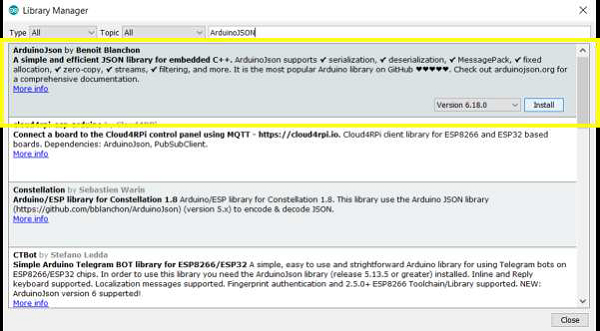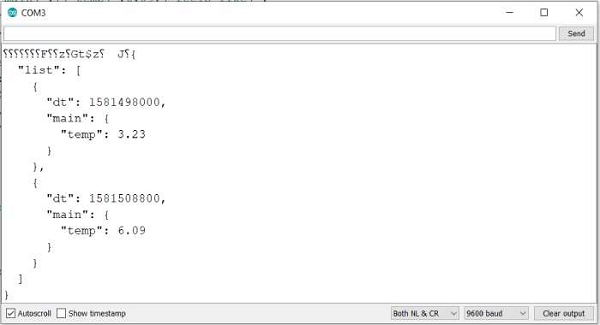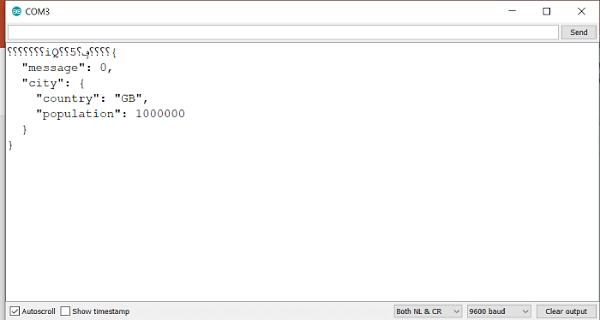ArduinoJSON:資料過濾
顧名思義,ArduinoJSON 庫有助於你在 Arduino 上處理 JSON 物件。要安裝它,請轉到庫管理器並搜尋 ArduinoJSON。安裝 Benoit Blanchon 開發的庫。

這是文件非常齊全的庫之一。事實上,它有自己的網站 - https://arduinojson.org/。你可以在該網站上找到許多問題的答案。
在本文中,我們將瞭解如何從較大的 JSON 中過濾資料並生成較小的 JSON。
下載 ArduinoJSON 庫後,轉到:檔案→示例→ArduinoJSON
示例
我們應該檢視的示例是 JsonFilterExample。程式碼如下:
#include <ArduinoJson.h>
void setup() {
// Initialize serial port
Serial.begin(9600);
while (!Serial) continue;
// The huge input: an extract from OpenWeatherMap response
const __FlashStringHelper* input_json = F("{\"cod\":\"200\",\"message\":0,\"list [{\"dt\":1581498000,\"main\":{"
"\"temp\":3.23,\"feels_like\":- 3.63,\"temp_min\":3.23,\"temp_max\":4.62,"
"\"pressure\":1014,\"sea_level\":1014,\"grnd_level\":1010,\"humidity\":" "58,\"temp_kf\":-
1.39},\"weather\":[{\"id\":800,\"main\":\"Clear\","
"\"description\":\"clear "
"sky\",\"icon\":\"01d\"}],\"clouds\":{\"all\":0},\"wind\":{\"speed\":6." "19,\"deg\":266},\"sys\":{\"pod\":\"d\"},\"dt_txt\":\"2020-02-12 "
"09:00:00\"},{\"dt\":1581508800,\"main\":{\"temp\":6.09,\"feels_like\":-
"
"1.07,\"temp_min\":6.09,\"temp_max\":7.13,\"pressure\":1015,\"sea_"
"level\":1015,\"grnd_level\":1011,\"humidity\":48,\"temp_kf\":- 1.04},
"\"weather\":[{\"id\":800,\"main\":\"Clear\",\"description\":\"clear "
"sky\",\"icon\":\"01d\"}],\"clouds\":{\"all\":9},\"wind\":{\"speed\":6."
"64,\"deg\":268},\"sys\":{\"pod\":\"d\"},\"dt_txt\":\"2020-02-12 "
"12:00:00\"}],\"city\":{\"id\":2643743,\"name\":\"London\",\"coord\":{"
"\"lat\":51.5085,\"lon\":- 0.1257},\"country\":\"GB\",\"population\":"
"1000000,\"timezone\":0,\"sunrise\":1581492085,\"sunset\":1581527294}}");
// The filter: it contains "true" for each value we want to keep
StaticJsonDocument<200> filter;
filter["list"][0]["dt"] = true;
filter["list"][0]["main"]["temp"] = true;
// Deserialize the document
StaticJsonDocument<400> doc;
deserializeJson(doc, input_json, DeserializationOption::Filter(filter));
// Print the result
serializeJsonPretty(doc, Serial);
}
void loop() {
// not used in this example
}如你所見,在草圖的開頭,一個非常大的 JSON 載入到快閃記憶體中。這是一個非常大的 JSON。如果你以漂亮的格式視覺化它,它看起來是這樣的:
{
"cod":"200",
"message":0,
"list":[
{
"dt":1581498000,
"main":{
"temp":3.23,
"feels_like":-3.63,
"temp_min":3.23,
"temp_max":4.62,
"pressure":1014,
"sea_level":1014,
"grnd_level":1010,
"humidity":58,
"temp_kf":-1.39
},
"weather":[
{
"id":800,
"main":"Clear",
"description":"clear sky",
"icon":"01d"
}
],
"clouds":{
"all":0
},
"wind":{
"speed":6.19,
"deg":266
},
"sys":{
"pod":"d"
},
"dt_txt":"2020-02-12 09:00:00"
},
{
"dt":1581508800,
"main":{
"temp":6.09,
"feels_like":-1.07,
"temp_min":6.09,
"temp_max":7.13,
"pressure":1015,
"sea_level":1015,
"grnd_level":1011,
"humidity":48,
"temp_kf":-1.04
},
"weather":[
{
"id":800,
"main":"Clear",
"description":"clear sky",
"icon":"01d"
}
],
"clouds":{
"all":9
},
"wind":{
"speed":6.64,
"deg":268
},
"sys":{
"pod":"d"
},
"dt_txt":"2020-02-12 12:00:00"
}
],
"city":{
"id":2643743,
"name":"London",
"coord":{
"lat":51.5085,
"lon":-0.1257
},
"country":"GB",
"population":1000000,
"timezone":0,
"sunrise":1581492085,
"sunset":1581527294
}
}現在,我們不希望 JSON 文件中包含所有這些資料。因此,我們定義要保留的鍵的過濾器。如你所見,我們希望保留來自“list”陣列的“dt”鍵,以及來自“list”陣列的“main”鍵的巢狀“temp”鍵。因此,我們建立一個新的 JSON 文件過濾器,其中包含這些鍵。
StaticJsonDocument<200> filter; filter["list"][0]["dt"] = true; filter["list"][0]["main"]["temp"] = true;
過濾器 JSON 將如下所示:
{
"list": [
{"dt":true}
{ "main": {
{"temp": true}
}
]
}在 deserializeJson 函式中,我們添加了第三個引數,該引數實現了此過濾器。
deserializeJson(doc, input_json, DeserializationOption::Filter(filter));
輸出
現在,當我們在序列埠監視器上列印此 JSON 文件時,輸出如下:

如你所見,輸出中僅存在你指定的鍵。因此,使用過濾功能將非常大的 JSON 減少到較小的 JSON。這節省了空間並降低了複雜性。
再舉一個例子,如果你想保留“message”鍵以及來自“city”鍵的“country”和“population”鍵,你的過濾器 JSON 將如下所示:
StaticJsonDocument<200> filter; filter["message"] = true; filter["city"]["country"] = true; filter["city"]["population"] = true;
序列埠監視器輸出將如下所示:


廣告

 資料結構
資料結構 網路
網路 關係型資料庫管理系統
關係型資料庫管理系統 作業系統
作業系統 Java
Java iOS
iOS HTML
HTML CSS
CSS Android
Android Python
Python C 程式設計
C 程式設計 C++
C++ C#
C# MongoDB
MongoDB MySQL
MySQL Javascript
Javascript PHP
PHP